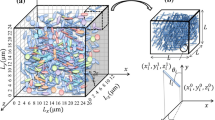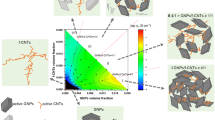Abstract
Electrical percolating composites of polypropylene (PP) filled with five different graphene nanoplatelet (GNP) fillers and their hybrid systems were prepared using melt blending. The effect of GNP size and their hybrid system on the conductive network formation is investigated. The formation of a conductive network can be affected by the structure and morphology of GNPs of different sizes. The GNPs with a larger diameter and smaller thickness are beneficial to produce a conductive network. The conductivity of the PP/GNP composite depends on the aspect ratio of the GNPs when the content exceeds the percolation threshold. However, when the GNP content is near the percolation threshold, both diameter and dispersion of the GNPs can affect the conductivity significantly, and electron tunneling theory should be taken in account. The highest electrical conductivity was obtained for a PP/large-diameter GNPs/medium-diameter GNPs hybrid system. To explain the hybrid system, an “island-bridge”-structured conductive network is proposed. The better conducting network may be due to scattered “islands” that connect with each other via a long “bridge.” This bridge links the islands for better charge transport across the GNPs and the obstruction of PP matrix, which enables the formation of a better conducting network. Even though GNPs with small diameter show perfect dispersion, they contribute less to the formation of a conductive network.












Similar content being viewed by others
References
Müller MT, Pötschke P, Voit B (2015) Dispersion of carbon nanotubes into polyethylene by an additive assisted one-step melt mixing approach. Polymer 66:210–221
Shui J, Wang M, Du F, Dai L (2015) N-doped carbon nanomaterials are durable catalysts for oxygen reduction reaction in acidic fuel cells. Sci Adv 1(1):e1400129–e1400129
Battisti A, Skordos AA, Partridge IK (2010) Percolation threshold of carbon nanotubes filled unsaturated polyesters. Compos Sci Technol 70(4):633–637
Ahmadi-Moghadam B, Taheri F (2014) Effect of processing parameters on the structure and multi-functional performance of epoxy/GNP-nanocomposites. J Mater Sci 49(18):6180–6190. doi:10.1007/s10853-014-8332-y
Torrisi F, Hasan T, Wu W, Sun Z, Lombardo A, Kulmala TS et al (2011) Inkjet-printed graphene electronics. ACS Nano 6(4):2992–3006
Chen G, Xu W, Zhu D (2017) Recent advances in organic polymer thermoelectric composites. J Mater Chem C 5(18):4350–4360
Zhang Z, Chen G, Wang H et al (2015) Template-directed in situ polymerization preparation of nanocomposites of PEDOT: PSS-coated multi-walled carbon nanotubes with enhanced thermoelectric property. Chem Asian J 10(1):149–153
Cao WQ, Wang XX, Yuan J, Wang W, Cao MS (2015) Temperature dependent microwave absorption of ultrathin graphene composites. J Mater Chem C 3(38):10017–10022
Wen B, Cao M, Lu M, Cao W, Shi H, Liu J et al (2014) Reduced graphene oxides: light-weight and high-efficiency electromagnetic interference shielding at elevated temperatures. Adv Mater 26(21):3484–3489
Smith JG, Delozier DM, Connell JW, Watson KA (2004) Carbon nanotube-conductive additive-space durable polymer nanocomposite films for electrostatic charge dissipation. Polymer 45(18):6133–6142
Balberg I (2002) A comprehensive picture of the electrical phenomena in carbon black–polymer composites. Carbon 40(2):139–143
Li ZM, Xu XB, Lu A, Shen KZ, Huang R, Yang MB (2004) Carbon black/poly(ethylene terephthalate)/polyethylene composite with electrically conductive in situ microfiber network. Carbon 42(2):428–432
Drubetski M, Siegmann A, Narkis M (2005) Hybrid particulate and fibrous injection molded composites: carbon black/carbonfiber/polypropylene systems. Polym Compos 26(4):454–464
Paglicawan MA, Kim JK, Bang DS (2010) Dispersion of multiwalled carbon nanotubes in thermoplastic elastomer gels: morphological, rheological, and electrical properties. Polym Compos 31(2):210–217
Du X, Skachko I, Barker A, Andrei EY (2008) Approaching ballistic transport in suspended graphene. Nat Nanotechnol 3(8):491–495
Yong Q, Lu S, Gao F (2011) Preparation of MnO2/graphene composite as electrode material for supercapacitors. J Mater Sci 46(10):3517–3522. doi:10.1007/s10853-011-5260-y
Balandin AA, Ghosh S, Bao W, Calizo I, Teweldebrhan D, Miao F et al (2008) Superior thermal conductivity of single-layer graphene. Nano Lett 8(3):902–907
Du J, Cheng HM (2012) The fabrication, properties, and uses of graphene/polymer composites. Macromol Chem Phys 213(10–11):1060–1077
Rajagopal C, Satyam M (1978) Studies on electrical conductivity of insulator–conductor composites. J Appl Phys 49(11):5536–5542
Sheng P, Sichel EK, Gittleman JI (1978) Fluctuation-induced tunneling conducting in carbon-polyvinylchloride composites. Phys Rev Lett 40(18):1197–1200
Menzer K, Krause B, Boldt R, Kretzschmar B, Weidisch R et al (2011) Percolation behaviour of multiwalled carbon nanotubes of altered length and primary agglomerate morphology in melt mixed isotactic polypropylene-based composites. Compos Sci Technol 71(16):1936–1943
Zhang J, He S, Lv P, Chen Y (2016) Processing–morphology–property relationships of polypropylene–graphene nanoplatelets nanocomposites. J Appl Polym Sci 134(8):44486-44495
Guehenec M, Tishkova V, Dagreou S, Leonardi F, Derailet C, Puech P et al (2013) The effect of twin screw extrusion on structural, electrical, and rheological properties in carbon nanotube poly-ether-ether-ketone nanocomposites. J Appl Polym Sci 129(5):2527–2535
Müller MT, Krause B, Kretzschmar B, Pötschke P (2011) Influence of feeding conditions in twin-screw extrusion of PP/MWCNT composites on electrical and mechanical properties. Compos Sci Technol 71(13):1535–1542
Kasaliwal GR, Pegel S, Göldel A et al (2010) Analysis of agglomerate dispersion mechanisms of multiwalled carbon nanotubes during melt mixing in polycarbonate. Polymer 51(12):2708–2720
Fukushima H, Drzal LT (2006) Nylon-exfoliated graphite nanoplatelet (xGnP) nanocomposites with enhanced mechanical, electrical and thermal properties, vol 1. NSTI Nanotech, PP 282–285. http://www.nsti.org
Kalaitzidou K, Fukushima H, Drzal LT (2007) A new compounding method for exfoliated graphite-polypropylene nanocomposites with enhanced flexural properties and lower percolation threshold. Compos Sci Technol 67(10):2045–2051
Wu H, Drzal LT (2013) Graphene nanoplatelet-polyetherimide composites: revealed morphology and relation to properties. J Appl Polym Sci 130(6):4081–4089
Dang ZM, Shehzad K, Zha JW, Mujahid A, Hussain T, Nie J et al (2011) Complementary percolation characteristics of carbon fillers based electrically percolative thermoplastic elastomer composites. Compos Sci Technol 72(1):28–35
Wen M, Sun X, Su L, Shen J, Li J, Guo S (2012) The electrical conductivity of carbon nanotube/carbon black/polypropylene composites prepared through multistage stretching extrusion. Polymer 53(7):1602–1610
Mayoral B, Harkin-Jones E, Khanam NP, Al-Maadeed M, Ouederni M et al (2015) Melt processing and characterisation of polyamide 6/graphene nanoplatelet composites. RSC Adv 5(65):52395–52409
Kalaitzidou K, Fukushima H, Drzal LT (2007) Mechanical properties and morphological characterization of exfoliated graphite-polypropylene nanocomposites. Compos Part A Appl Sci Manuf 38(7):1675–1682
Wu H, Drzal LT (2012) Graphene nanoplatelet paper as a light-weight composite with excellent electrical and thermal conductivity and good gas barrier properties. Carbon 50(3):1135–1145
Vallés C, Abdelkader AM, Young RJ, Kinloch IA (2015) The effect of flake diameter on the reinforcement of few-layer graphene–PMMA composites. Compos Sci Technol 111:17–22
Brown RP, Brandrup PJ, Immergut EH (1990) Polymer handbook. Polym Test 9(4):281–283
Liu W, Fukushima H, Drzal LT (2010) Influence of processing on morphology, electrical conductivity and flexural properties of exfoliated graphite nanoplatelets-polyamide nanocomposites. Carbon Lett 11(4):279–284
Zhang HB, Zheng WG, Yan Q, Yanga Y, Wanga JW, Lu ZH et al (2010) Electrically conductive polyethylene terephthalate/graphene nanocomposites prepared by melt compounding. Polymer 51(5):1191–1196
Zhong J, Isayev AI (2015) Properties of polyetherimide/graphite composites prepared using ultrasonic twin-screw extrusion. J Appl Polym Sci 132(5):41397–41407
Xu S, Wen M, Li J, Guo S, Wang M et al (2008) Structure and properties of electrically conducting composites consisting of alternating layers of pure polypropylene and polypropylene with a carbon black filler. Polymer 49(22):4861–4870
Chen Y, Li H (2005) Effect of ultrasound on the morphology and properties of polypropylene/inorganic filler composites. J Appl Polym Sci 97(4):1553–1560
Peng B, Wu H, Bao W, Guo S, Chen Y, Huang H et al (2010) Polym J 43(1):91–96
Andrews R, Jacques D, Minot M, Rantell T (2002) Fabrication of carbon multiwall nanotube/polymer composites by shear mixing. Macromol Mater Eng 287(6):395–403
Pötschke P, Villmow T, Krause B (2013) Melt mixed PCL/MWCNT composites prepared at different rotation speeds: characterization of rheological, thermal, and electrical properties, molecular weight, MWCNT macrodispersion, and MWCNT length distribution. Polymer 54(12):3071–3078
Du J, Cheng HM (2012) The fabrication, properties, and uses of graphene/polymer composites. Macromol Chem Phys 213(10–11):1060–1077
Novoselov KS, Geim AK, Morozov SV, Jiang D, Zhang Y, Dubonos SV et al (2004) Electric field effect in atomically thin carbon films. Science 306(5696):666–669
Kalaitzidou K, Fukushima H, Drzal LT (2007) Multifunctional polypropylene composites produced by incorporation of exfoliated graphite nanoplatelets. Carbon 45(7):1446–1452
Pegel S, Pötschke P, Petzold G, Alig I, Dudkin SM (2008) Dispersion, agglomeration, and network formation of multiwalled carbon nanotubes in polycarbonate melts. Polymer 49(4):974–984
Jiang X, Drzal LT (2012) Reduction in percolation threshold of injection molded high-density polyethylene/exfoliated graphene nanoplatelets composites by solid state ball milling and solid state shear pulverization. J Appl Polym Sci 124(1):525–535
Huang W, Brian R, Drzal LT (2013) Dispersion optimization of exfoliated graphene nanoplatelet in polyetherimide nanocomposites: extrusion, precoating, and solid state ball milling. Polym Compos 34(3):426–432
Zhong J, Isayev AI, Zhang X (2016) Ultrasonic twin screw compounding of polypropylene with carbon nanotubes, graphene nanoplates and carbon black. Eur Polym J 80:16–39
Iqbal MZ, Abdala AA, Mittal V, Seifert S, Herring AM et al (2016) Processable conductive graphene/polyethylene nanocomposites: effects of graphene dispersion and polyethylene blending with oxidized polyethylene on rheology and microstructure. Polymer 98:143–155
Devpura A, Phelan PE, Prasher RS (2001) Size effects on the thermal conductivity of polymers laden with highly conductive filler particles. Nanosc Microsc Therm 5(3):177–189
Polley MH, Boonstra BBST (1957) Carbon blacks for highly conductive rubber. Rubber Chem Technol 30:170–179
Drubetski M, Siegmann A, Narkis M (2007) Electrical properties of hybrid carbon black/carbon fiber polypropylene composites. J Mater Sci 42(1):1–8. doi:10.1007/s10853-006-1203-4
Ma P, Liu M, Zhang H, Wang S, Wang R, Wang K et al (2009) Enhanced electrical conductivity of nanocomposites containing hybrid fillers of carbon nanotubes and carbon black. ACS Appl Mater Interface 1(5):1090–1096
Acknowledgements
The financial support from the Science and Technology Project of Guangdong Province (No. 2013B090600069) is acknowledged.
Author information
Authors and Affiliations
Corresponding author
Rights and permissions
About this article
Cite this article
He, S., Zhang, J., Xiao, X. et al. Investigation of the conductive network formation of polypropylene/graphene nanoplatelets composites for different platelet sizes. J Mater Sci 52, 13103–13119 (2017). https://doi.org/10.1007/s10853-017-1413-y
Received:
Accepted:
Published:
Issue Date:
DOI: https://doi.org/10.1007/s10853-017-1413-y




